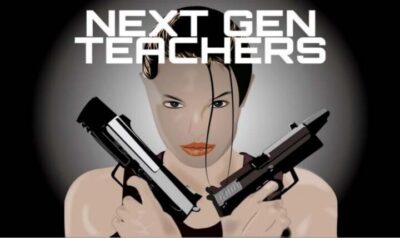By B.A. Calhoun
In the wake of the Uvalde, Texas shooting at Robb Elementary School, the conversation surrounding gun reform and gun laws in political circles has so intensified that we are now seeing nearly immediate changes across the nation as well as in Cleveland’s own state of Ohio.
Following the tragic slayings of 19 children and 2 adults at Robb Elementary, in the preceding month, President Biden signed into law major gun safety legislation with restrictions meant to reduce gun violence. This was the first significant gun law that passed through Congress in nearly three decades, according to the White House briefing room statements (whitehouse.gov) and as reported by the New York Times. This swift and historical address to gun violence compares to state lawmakers who are also seeking solutions for safety in their states. Governor DeWine signed into law the fast-tracked House Bill 99, which reduces the required training of 700 hours to 24 hours in order for teachers to carry firearms within Ohio schools. This is an approach that is meant to see teachers quickly trained and armed as a possible line of defense in the case of an active shooter. DeWine’s new law has been met with a mixture of views, some in support by his Republican counterparts, but also many opposing statements made by democratic representatives as found on the Ohio House of Representatives website. (OhioHouse.gov). Historically, laws have often been established with minimal input from the individuals whom these laws directly affect. Since putting firearms in the hands of teachers is under the scope of solutions, what are Ohio teachers saying about this new law and how will this impact them and their students?
“It’s concerning,” says a Greater Cleveland resident and educator for over 20 years. “Because of the amount of training that is necessary. I mean, you are just arming all these teachers and not training them properly. How can the required hours for training decrease from 700 hours to only 24 hours?” As a current k-8 teacher for a Cleveland charter school, this educator does not see this new law as a practical solution. She had a real concern about the reduction in training hours as well as how much of the required time in training is truly focused on handling firearms.
“I hear the supporters of this law saying you wouldn’t be able to protect yourself, fire back, and protect our kids, and I get that. But if I was to see myself in a situation where there is an active shooter in the building and I am in the classroom teaching, just take a moment to think about how that looks. More than likely, it is just not going to go the way we expect! As a teacher, you are going to want to make sure the kids are as safe as they can be of course, but then you are expected to think, ‘let me go get that gun and remember those few hours of training I had.’” She laughed as she pictures the scenario. “It just takes a whole other set of skill and reasoning to add to an already dangerous situation. People are saying we need guns at school, but they haven’t talked to us (teachers/staff) on how to store these weapons properly or keep them safe and away from our students. And we must also consider, teachers have rough days too!”
Speaking with another educator, one who has taught primarily in CMSD as a substitute teacher, she shared a very different perspective. “I think it’s good!” She shared that schools are not always as secure as we hope for, and she shed light on alternative access points of entry that students are aware of besides the main entrance, where security measures may not be in place. When it comes to safety in schools, this teacher gave scenarios of violent fights between students. “I will not break up a fight!” She disclosed that based on violent altercations she has seen in schools. When asked if she believed that teachers are afraid of their students she emphatically replied, “Yes!”
So the question rises, how would an armed teacher respond to a student they felt threatened by?
“The law is a good idea, but frankly some teachers have already been carrying at school. This is a good law, as long as there is adequate training.”
But a 20-year vet has a very different relationship with her students. “I teach Art. The environment I set is a safe place for students to express themselves creatively, this channels into their art. I have a good rapport with my students. As one of the few African Americans in the building, the kids find me relatable. Someone that gives good advice, and they can be themselves around.”
She acknowledged that during her stretch as an educator at CMSD she has seen fights become violent, as well as threats of killing or harming. She recalled seeing violence manifest in her early years as an educator while teaching in a bridge program to help transition children from the juvenile system into mainstream education but gun safety in school does not seem to be of major concern for her.
“No, I don’t feel like in these schools that I’ve worked in that students would come in and shoot up the school. If students had an issue with someone, they had it with that individual and it would happen in the neighborhood or somewhere else. But they would not bring it to their schools or hold others hostage. This is something I have never been concerned about. Even if confrontations might have been amongst a group of students, it is not a situation where they are threatening harm on the entire school. I have not felt like students would do anything to me in particular because of my relationship with the students. Even if there were a case that a student would try to harm me, I feel like the other students would step in. But there have been students where it’s been a concern about their mental state or emotional state. We as educators recognize the issue and see we need to take care of this particular child. They may go off and harm another child. But I don’t think even my coworkers were concerned about or felt afraid that a student would hurt them.”
When it comes to DeWine’s new law, this teacher’s insight regarding school safety highlighted further uncertainties. She went on to say, “It’s more concerning to me that we want to arm teachers! Teachers are coming to school to teach their students. I mean, it just changes your whole mindset when you come into the building armed. It’s not something that I feel like is necessary, at least not in our schools. Honestly, I never felt that students were going to come in and harm everyone in the building. But we have had a few threats this year which is something new and something we had not seen before.” She believes these new threats seem to be a derivative of the pandemic era.
Could guns be the solution to guns? Our Ohio teachers are advocating alternative and proactive solutions to encourage safety in our schools. These solutions call to bolster security on school grounds, exercises and programs at school for teachers to address emotional and mental health issues, and how students can benefit from school counselors and other professionals.
“It is important to have relationships with our students, be more aware, and have these elements in place for them. A place where students know they have a safe place to go.”
A closer look into what these solutions look like, a further look into this issue of gun violence at schools, and how the pandemic has triggered new concerns for gun safety at school is coming soon.






